Analysis of Human Resource Management Policies at HSBC
VerifiedAdded on 2020/10/05
|12
|3952
|113
Report
AI Summary
This report provides an in-depth analysis of human resource management practices within HSBC. It begins by outlining the core functions of an HR department, including resource planning, providing direction and vision, fostering a motivational environment, and employee development. The report emphasizes the importance of setting good examples, leading customer service efforts, and resolving employee obstacles. It then explores the impact of both internal and external factors on HSBC's HRM policies. Internal factors discussed include the company's mission, policies, and organizational culture, highlighting potential conflicts arising from personal goals, rights versus duties, self-confidence versus arrogance, and authority versus responsibility. The report underscores the significance of understanding company objectives and providing employees with necessary tools. This report provides a comprehensive overview of HSBC's approach to managing its human capital and the factors that shape its HR strategies.
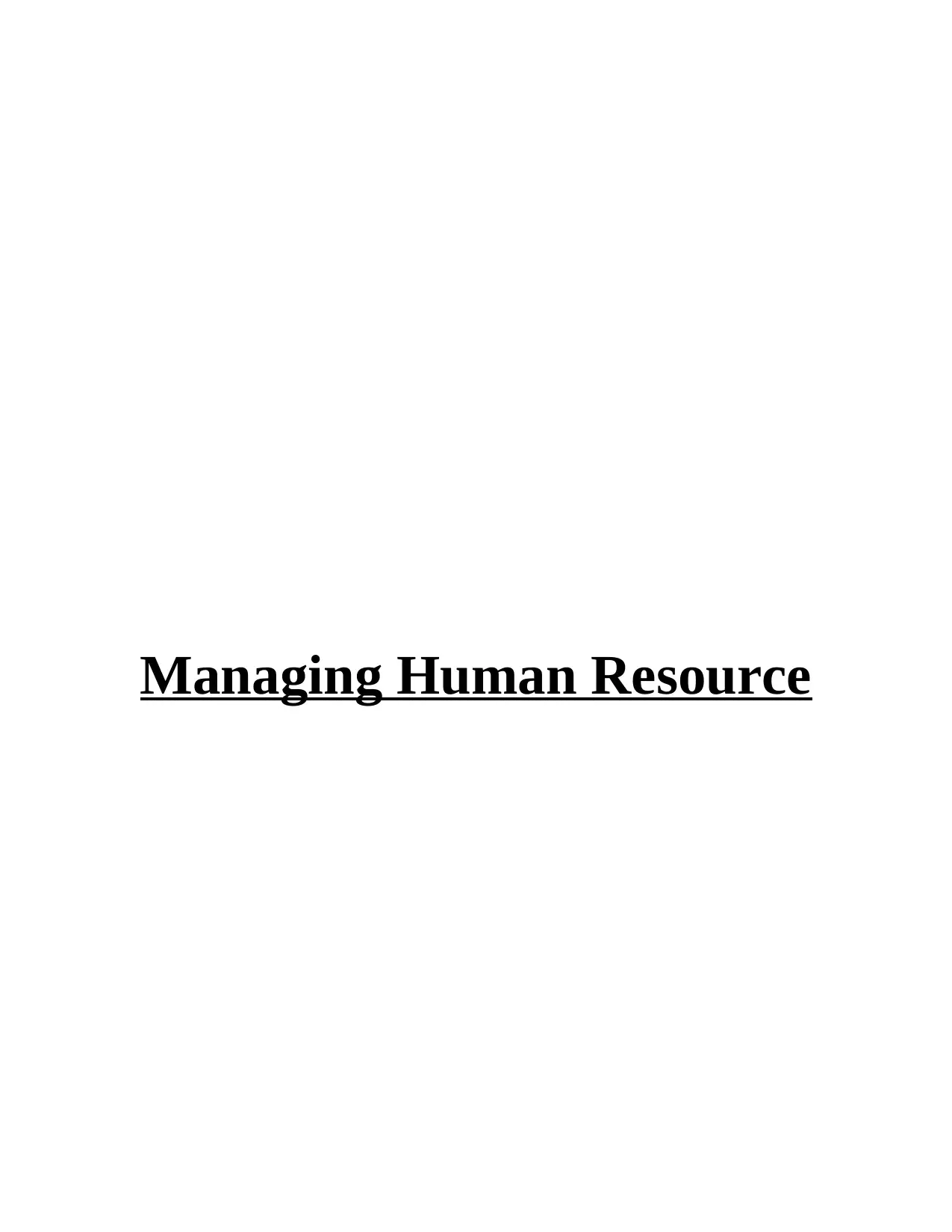
Managing Human Resource
Paraphrase This Document
Need a fresh take? Get an instant paraphrase of this document with our AI Paraphraser
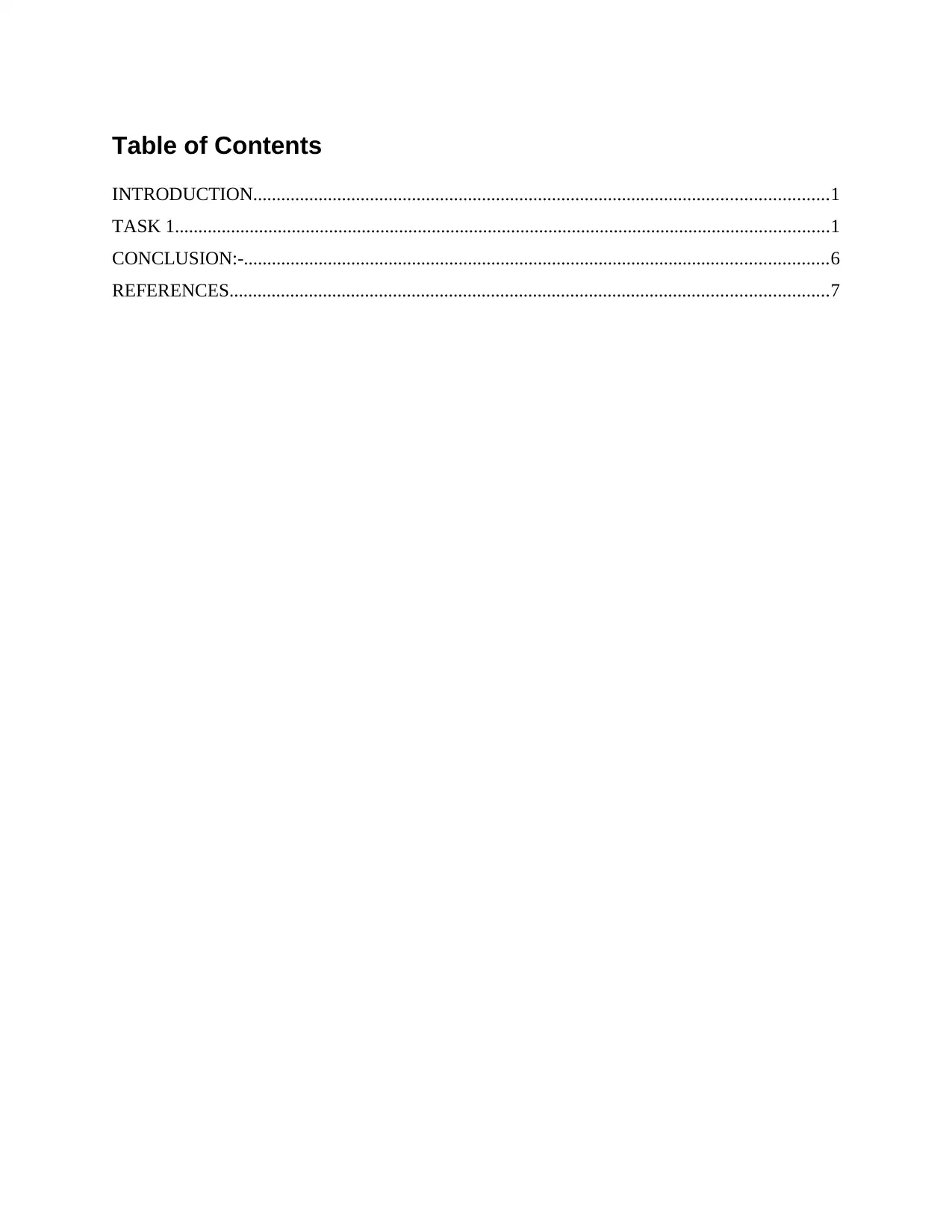
Table of Contents
INTRODUCTION...........................................................................................................................1
TASK 1............................................................................................................................................1
CONCLUSION:-.............................................................................................................................6
REFERENCES................................................................................................................................7
INTRODUCTION...........................................................................................................................1
TASK 1............................................................................................................................................1
CONCLUSION:-.............................................................................................................................6
REFERENCES................................................................................................................................7
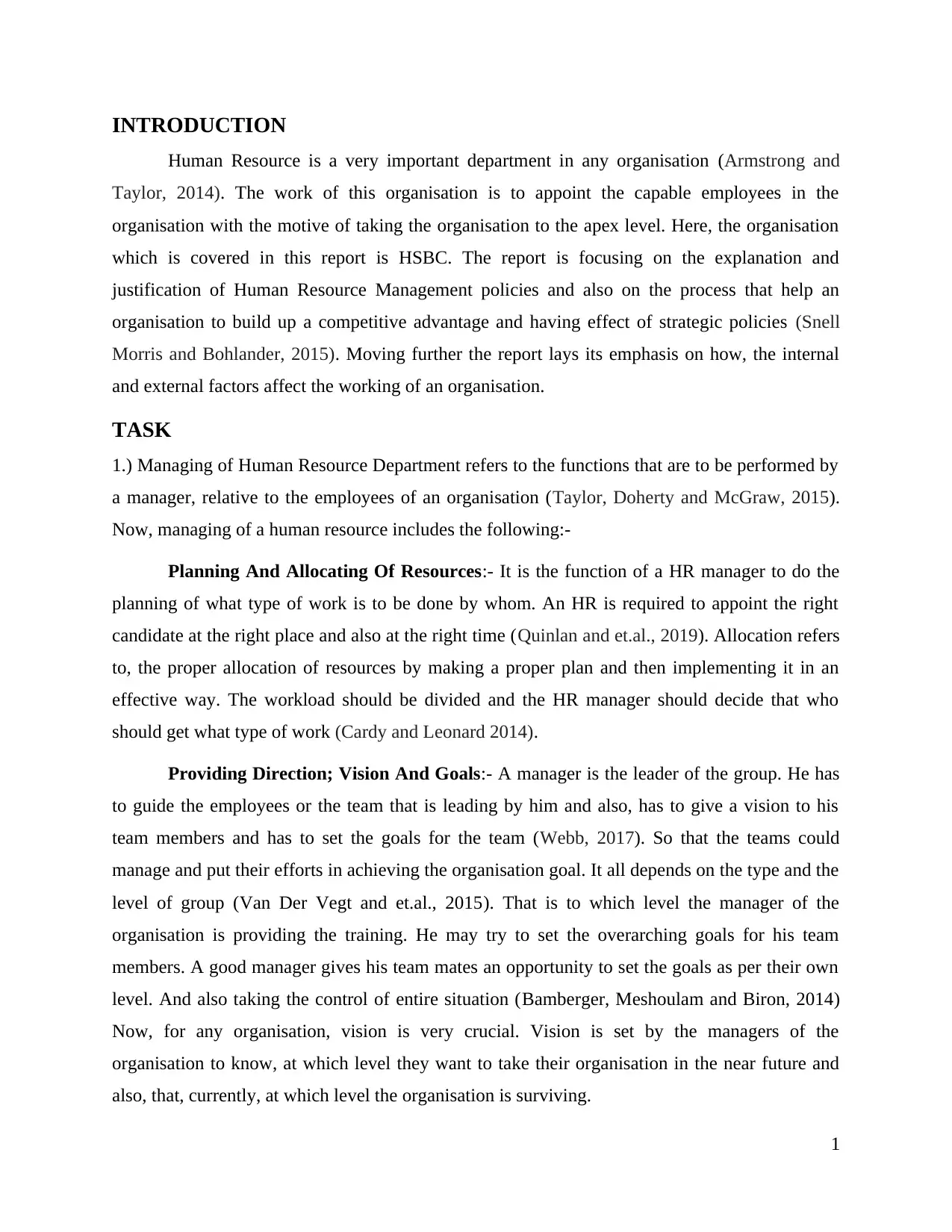
INTRODUCTION
Human Resource is a very important department in any organisation (Armstrong and
Taylor, 2014). The work of this organisation is to appoint the capable employees in the
organisation with the motive of taking the organisation to the apex level. Here, the organisation
which is covered in this report is HSBC. The report is focusing on the explanation and
justification of Human Resource Management policies and also on the process that help an
organisation to build up a competitive advantage and having effect of strategic policies (Snell
Morris and Bohlander, 2015). Moving further the report lays its emphasis on how, the internal
and external factors affect the working of an organisation.
TASK
1.) Managing of Human Resource Department refers to the functions that are to be performed by
a manager, relative to the employees of an organisation (Taylor, Doherty and McGraw, 2015).
Now, managing of a human resource includes the following:-
Planning And Allocating Of Resources:- It is the function of a HR manager to do the
planning of what type of work is to be done by whom. An HR is required to appoint the right
candidate at the right place and also at the right time (Quinlan and et.al., 2019). Allocation refers
to, the proper allocation of resources by making a proper plan and then implementing it in an
effective way. The workload should be divided and the HR manager should decide that who
should get what type of work (Cardy and Leonard 2014).
Providing Direction; Vision And Goals:- A manager is the leader of the group. He has
to guide the employees or the team that is leading by him and also, has to give a vision to his
team members and has to set the goals for the team (Webb, 2017). So that the teams could
manage and put their efforts in achieving the organisation goal. It all depends on the type and the
level of group (Van Der Vegt and et.al., 2015). That is to which level the manager of the
organisation is providing the training. He may try to set the overarching goals for his team
members. A good manager gives his team mates an opportunity to set the goals as per their own
level. And also taking the control of entire situation (Bamberger, Meshoulam and Biron, 2014)
Now, for any organisation, vision is very crucial. Vision is set by the managers of the
organisation to know, at which level they want to take their organisation in the near future and
also, that, currently, at which level the organisation is surviving.
1
Human Resource is a very important department in any organisation (Armstrong and
Taylor, 2014). The work of this organisation is to appoint the capable employees in the
organisation with the motive of taking the organisation to the apex level. Here, the organisation
which is covered in this report is HSBC. The report is focusing on the explanation and
justification of Human Resource Management policies and also on the process that help an
organisation to build up a competitive advantage and having effect of strategic policies (Snell
Morris and Bohlander, 2015). Moving further the report lays its emphasis on how, the internal
and external factors affect the working of an organisation.
TASK
1.) Managing of Human Resource Department refers to the functions that are to be performed by
a manager, relative to the employees of an organisation (Taylor, Doherty and McGraw, 2015).
Now, managing of a human resource includes the following:-
Planning And Allocating Of Resources:- It is the function of a HR manager to do the
planning of what type of work is to be done by whom. An HR is required to appoint the right
candidate at the right place and also at the right time (Quinlan and et.al., 2019). Allocation refers
to, the proper allocation of resources by making a proper plan and then implementing it in an
effective way. The workload should be divided and the HR manager should decide that who
should get what type of work (Cardy and Leonard 2014).
Providing Direction; Vision And Goals:- A manager is the leader of the group. He has
to guide the employees or the team that is leading by him and also, has to give a vision to his
team members and has to set the goals for the team (Webb, 2017). So that the teams could
manage and put their efforts in achieving the organisation goal. It all depends on the type and the
level of group (Van Der Vegt and et.al., 2015). That is to which level the manager of the
organisation is providing the training. He may try to set the overarching goals for his team
members. A good manager gives his team mates an opportunity to set the goals as per their own
level. And also taking the control of entire situation (Bamberger, Meshoulam and Biron, 2014)
Now, for any organisation, vision is very crucial. Vision is set by the managers of the
organisation to know, at which level they want to take their organisation in the near future and
also, that, currently, at which level the organisation is surviving.
1
⊘ This is a preview!⊘
Do you want full access?
Subscribe today to unlock all pages.

Trusted by 1+ million students worldwide

Developing Environment Full Of Motivation And Contribution:- It is the duty of a
HR manger to create a motivational environment for its team members (Burt, 2017). The
manager of a team should create and try to develop a motivational environment within the
organisation for the team members. By doing this, the employees of organisation will always feel
motivated and inspired for doing the particular task (Burt, 2017). The team leaders or the
managers should organise some activities from which a feeling of contribution and serving for
the well being of others will be generated within the mind of employees. They will think of
doing contribution in the favour of organisation or someone else (Chelladurai and Kerwin,
2017).
Telling The Employees That They Are Doing Good In Their Job:- By making some
parameters for the evaluation of the employee performance, a feedback can be given by the
mangers to the employees who are working in their team (Riley, 2014). This can be done by
making a metrics that will tell the employees the feedback from their superiors that whether they
are going good or required to improve at some point (Wellin, M., 2016).
Offering Formal And Informal Development Opportunities To The Employees:- A
good HR manager should provide an opportunity of whether an employee wants to develop by
remaining in the formal or in the informal group (Turner, 2016). Managers should personally
give training to the employees by taking their classes and stretch projects. Such type of coaching
can be taken by the HR mangers by way of either formal mentoring or through providing a
feedback of employee performance on a regular basis (Turner, 2016).
Setting Some Good Examples In Front Of Them:- HR manager can set an example in
front of teammates by showing them how should they, behave with others by being ethical,
treating people in fairly manner, all such things gives people a sort of independence (Helmreich
and Merritt, 2017). The mangers who are doing any type of partiality/discrimination, by playing
in unfair manner against the staff members are just damaging the most valuable and important
resource of business i.e. people (Wellin, 2016).
Leading The Efforts Of Organisation To Listen And Serve Customers:- Since HR is
one of the most important department that recruits and hire the employees in the organisation
(Chelladurai and Kerwin, 2017). So, if the HR managers will not be there, then the pool of
talented and capable employees will be wasted in the market if not recruited on the right time.
2
HR manger to create a motivational environment for its team members (Burt, 2017). The
manager of a team should create and try to develop a motivational environment within the
organisation for the team members. By doing this, the employees of organisation will always feel
motivated and inspired for doing the particular task (Burt, 2017). The team leaders or the
managers should organise some activities from which a feeling of contribution and serving for
the well being of others will be generated within the mind of employees. They will think of
doing contribution in the favour of organisation or someone else (Chelladurai and Kerwin,
2017).
Telling The Employees That They Are Doing Good In Their Job:- By making some
parameters for the evaluation of the employee performance, a feedback can be given by the
mangers to the employees who are working in their team (Riley, 2014). This can be done by
making a metrics that will tell the employees the feedback from their superiors that whether they
are going good or required to improve at some point (Wellin, M., 2016).
Offering Formal And Informal Development Opportunities To The Employees:- A
good HR manager should provide an opportunity of whether an employee wants to develop by
remaining in the formal or in the informal group (Turner, 2016). Managers should personally
give training to the employees by taking their classes and stretch projects. Such type of coaching
can be taken by the HR mangers by way of either formal mentoring or through providing a
feedback of employee performance on a regular basis (Turner, 2016).
Setting Some Good Examples In Front Of Them:- HR manager can set an example in
front of teammates by showing them how should they, behave with others by being ethical,
treating people in fairly manner, all such things gives people a sort of independence (Helmreich
and Merritt, 2017). The mangers who are doing any type of partiality/discrimination, by playing
in unfair manner against the staff members are just damaging the most valuable and important
resource of business i.e. people (Wellin, 2016).
Leading The Efforts Of Organisation To Listen And Serve Customers:- Since HR is
one of the most important department that recruits and hire the employees in the organisation
(Chelladurai and Kerwin, 2017). So, if the HR managers will not be there, then the pool of
talented and capable employees will be wasted in the market if not recruited on the right time.
2
Paraphrase This Document
Need a fresh take? Get an instant paraphrase of this document with our AI Paraphraser
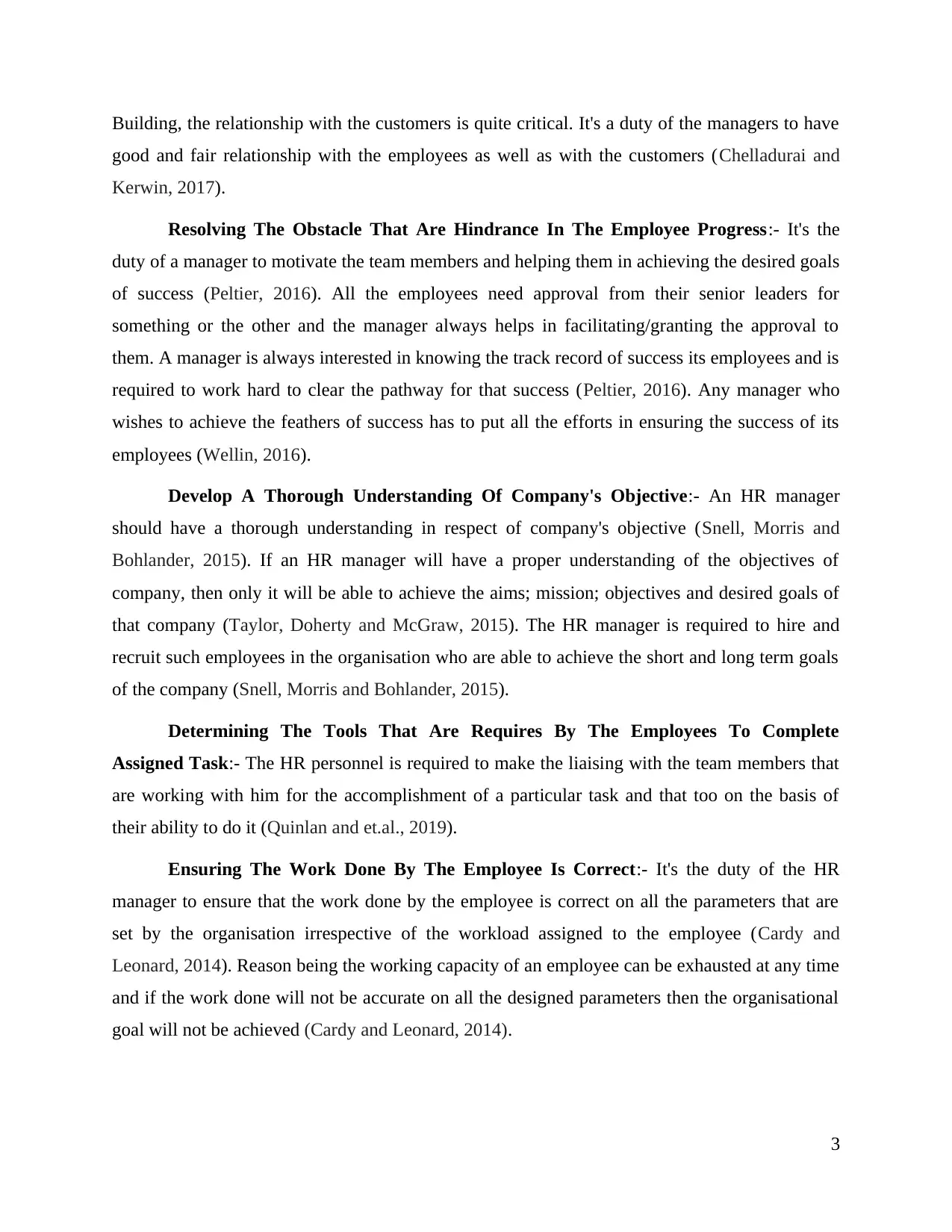
Building, the relationship with the customers is quite critical. It's a duty of the managers to have
good and fair relationship with the employees as well as with the customers (Chelladurai and
Kerwin, 2017).
Resolving The Obstacle That Are Hindrance In The Employee Progress:- It's the
duty of a manager to motivate the team members and helping them in achieving the desired goals
of success (Peltier, 2016). All the employees need approval from their senior leaders for
something or the other and the manager always helps in facilitating/granting the approval to
them. A manager is always interested in knowing the track record of success its employees and is
required to work hard to clear the pathway for that success (Peltier, 2016). Any manager who
wishes to achieve the feathers of success has to put all the efforts in ensuring the success of its
employees (Wellin, 2016).
Develop A Thorough Understanding Of Company's Objective:- An HR manager
should have a thorough understanding in respect of company's objective (Snell, Morris and
Bohlander, 2015). If an HR manager will have a proper understanding of the objectives of
company, then only it will be able to achieve the aims; mission; objectives and desired goals of
that company (Taylor, Doherty and McGraw, 2015). The HR manager is required to hire and
recruit such employees in the organisation who are able to achieve the short and long term goals
of the company (Snell, Morris and Bohlander, 2015).
Determining The Tools That Are Requires By The Employees To Complete
Assigned Task:- The HR personnel is required to make the liaising with the team members that
are working with him for the accomplishment of a particular task and that too on the basis of
their ability to do it (Quinlan and et.al., 2019).
Ensuring The Work Done By The Employee Is Correct:- It's the duty of the HR
manager to ensure that the work done by the employee is correct on all the parameters that are
set by the organisation irrespective of the workload assigned to the employee (Cardy and
Leonard, 2014). Reason being the working capacity of an employee can be exhausted at any time
and if the work done will not be accurate on all the designed parameters then the organisational
goal will not be achieved (Cardy and Leonard, 2014).
3
good and fair relationship with the employees as well as with the customers (Chelladurai and
Kerwin, 2017).
Resolving The Obstacle That Are Hindrance In The Employee Progress:- It's the
duty of a manager to motivate the team members and helping them in achieving the desired goals
of success (Peltier, 2016). All the employees need approval from their senior leaders for
something or the other and the manager always helps in facilitating/granting the approval to
them. A manager is always interested in knowing the track record of success its employees and is
required to work hard to clear the pathway for that success (Peltier, 2016). Any manager who
wishes to achieve the feathers of success has to put all the efforts in ensuring the success of its
employees (Wellin, 2016).
Develop A Thorough Understanding Of Company's Objective:- An HR manager
should have a thorough understanding in respect of company's objective (Snell, Morris and
Bohlander, 2015). If an HR manager will have a proper understanding of the objectives of
company, then only it will be able to achieve the aims; mission; objectives and desired goals of
that company (Taylor, Doherty and McGraw, 2015). The HR manager is required to hire and
recruit such employees in the organisation who are able to achieve the short and long term goals
of the company (Snell, Morris and Bohlander, 2015).
Determining The Tools That Are Requires By The Employees To Complete
Assigned Task:- The HR personnel is required to make the liaising with the team members that
are working with him for the accomplishment of a particular task and that too on the basis of
their ability to do it (Quinlan and et.al., 2019).
Ensuring The Work Done By The Employee Is Correct:- It's the duty of the HR
manager to ensure that the work done by the employee is correct on all the parameters that are
set by the organisation irrespective of the workload assigned to the employee (Cardy and
Leonard, 2014). Reason being the working capacity of an employee can be exhausted at any time
and if the work done will not be accurate on all the designed parameters then the organisational
goal will not be achieved (Cardy and Leonard, 2014).
3
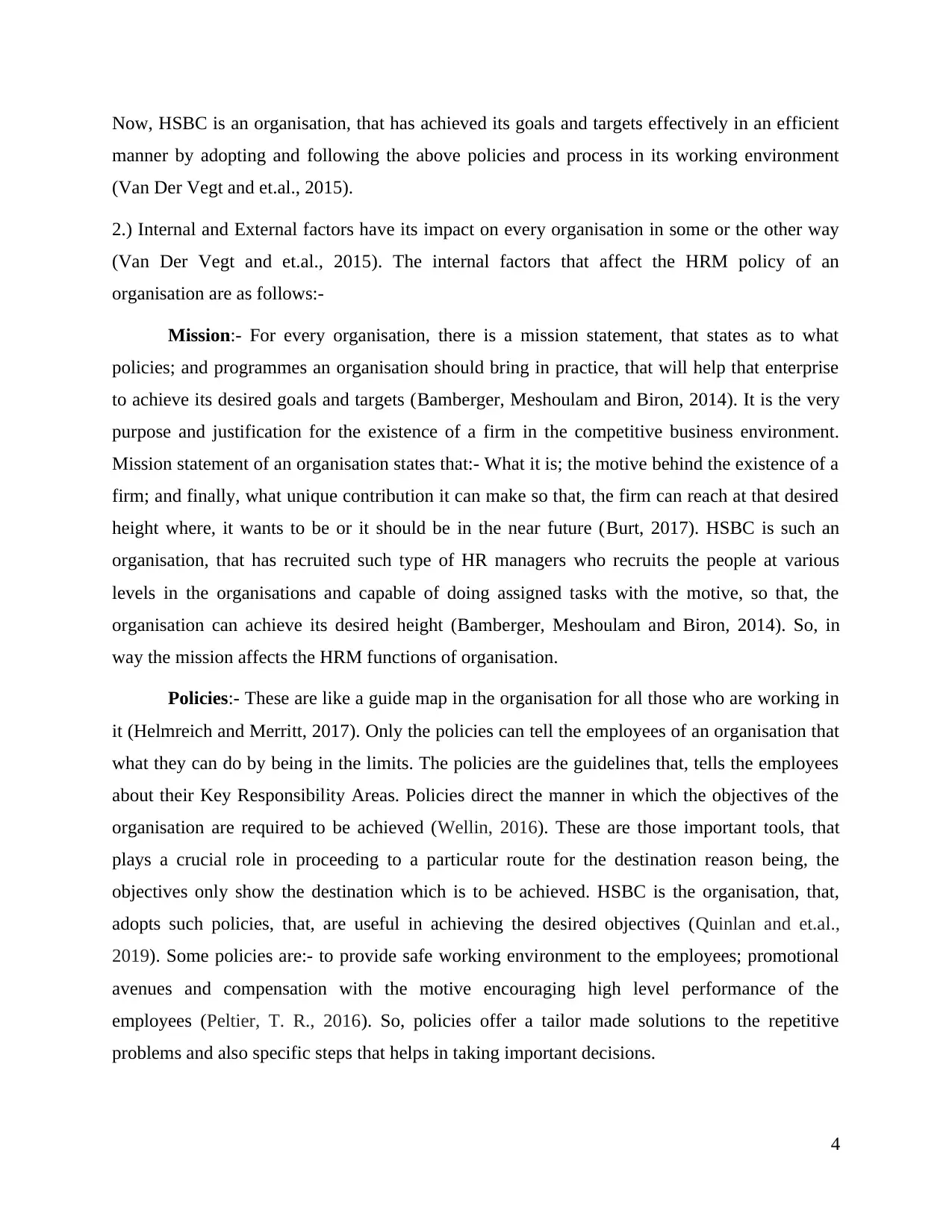
Now, HSBC is an organisation, that has achieved its goals and targets effectively in an efficient
manner by adopting and following the above policies and process in its working environment
(Van Der Vegt and et.al., 2015).
2.) Internal and External factors have its impact on every organisation in some or the other way
(Van Der Vegt and et.al., 2015). The internal factors that affect the HRM policy of an
organisation are as follows:-
Mission:- For every organisation, there is a mission statement, that states as to what
policies; and programmes an organisation should bring in practice, that will help that enterprise
to achieve its desired goals and targets (Bamberger, Meshoulam and Biron, 2014). It is the very
purpose and justification for the existence of a firm in the competitive business environment.
Mission statement of an organisation states that:- What it is; the motive behind the existence of a
firm; and finally, what unique contribution it can make so that, the firm can reach at that desired
height where, it wants to be or it should be in the near future (Burt, 2017). HSBC is such an
organisation, that has recruited such type of HR managers who recruits the people at various
levels in the organisations and capable of doing assigned tasks with the motive, so that, the
organisation can achieve its desired height (Bamberger, Meshoulam and Biron, 2014). So, in
way the mission affects the HRM functions of organisation.
Policies:- These are like a guide map in the organisation for all those who are working in
it (Helmreich and Merritt, 2017). Only the policies can tell the employees of an organisation that
what they can do by being in the limits. The policies are the guidelines that, tells the employees
about their Key Responsibility Areas. Policies direct the manner in which the objectives of the
organisation are required to be achieved (Wellin, 2016). These are those important tools, that
plays a crucial role in proceeding to a particular route for the destination reason being, the
objectives only show the destination which is to be achieved. HSBC is the organisation, that,
adopts such policies, that, are useful in achieving the desired objectives (Quinlan and et.al.,
2019). Some policies are:- to provide safe working environment to the employees; promotional
avenues and compensation with the motive encouraging high level performance of the
employees (Peltier, T. R., 2016). So, policies offer a tailor made solutions to the repetitive
problems and also specific steps that helps in taking important decisions.
4
manner by adopting and following the above policies and process in its working environment
(Van Der Vegt and et.al., 2015).
2.) Internal and External factors have its impact on every organisation in some or the other way
(Van Der Vegt and et.al., 2015). The internal factors that affect the HRM policy of an
organisation are as follows:-
Mission:- For every organisation, there is a mission statement, that states as to what
policies; and programmes an organisation should bring in practice, that will help that enterprise
to achieve its desired goals and targets (Bamberger, Meshoulam and Biron, 2014). It is the very
purpose and justification for the existence of a firm in the competitive business environment.
Mission statement of an organisation states that:- What it is; the motive behind the existence of a
firm; and finally, what unique contribution it can make so that, the firm can reach at that desired
height where, it wants to be or it should be in the near future (Burt, 2017). HSBC is such an
organisation, that has recruited such type of HR managers who recruits the people at various
levels in the organisations and capable of doing assigned tasks with the motive, so that, the
organisation can achieve its desired height (Bamberger, Meshoulam and Biron, 2014). So, in
way the mission affects the HRM functions of organisation.
Policies:- These are like a guide map in the organisation for all those who are working in
it (Helmreich and Merritt, 2017). Only the policies can tell the employees of an organisation that
what they can do by being in the limits. The policies are the guidelines that, tells the employees
about their Key Responsibility Areas. Policies direct the manner in which the objectives of the
organisation are required to be achieved (Wellin, 2016). These are those important tools, that
plays a crucial role in proceeding to a particular route for the destination reason being, the
objectives only show the destination which is to be achieved. HSBC is the organisation, that,
adopts such policies, that, are useful in achieving the desired objectives (Quinlan and et.al.,
2019). Some policies are:- to provide safe working environment to the employees; promotional
avenues and compensation with the motive encouraging high level performance of the
employees (Peltier, T. R., 2016). So, policies offer a tailor made solutions to the repetitive
problems and also specific steps that helps in taking important decisions.
4
⊘ This is a preview!⊘
Do you want full access?
Subscribe today to unlock all pages.

Trusted by 1+ million students worldwide
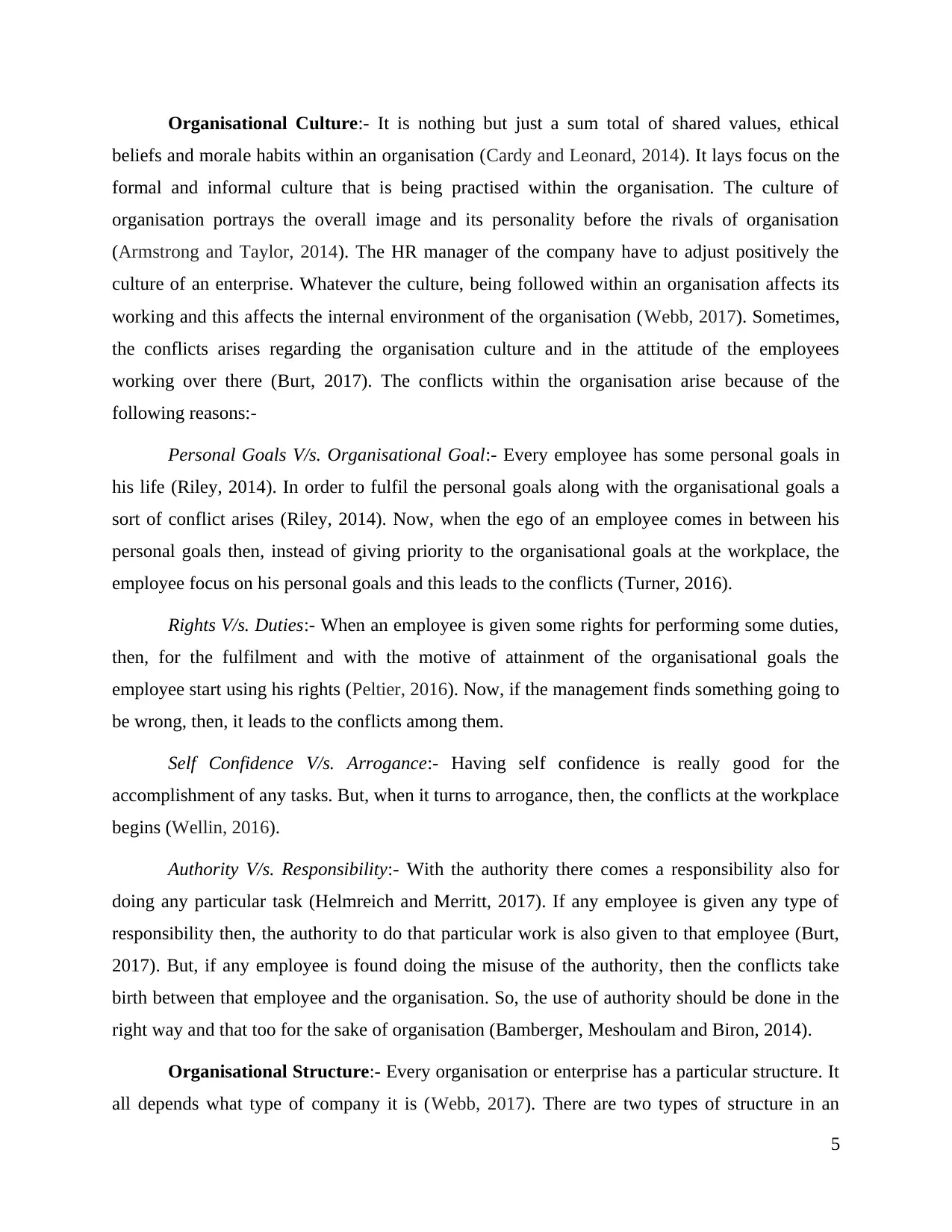
Organisational Culture:- It is nothing but just a sum total of shared values, ethical
beliefs and morale habits within an organisation (Cardy and Leonard, 2014). It lays focus on the
formal and informal culture that is being practised within the organisation. The culture of
organisation portrays the overall image and its personality before the rivals of organisation
(Armstrong and Taylor, 2014). The HR manager of the company have to adjust positively the
culture of an enterprise. Whatever the culture, being followed within an organisation affects its
working and this affects the internal environment of the organisation (Webb, 2017). Sometimes,
the conflicts arises regarding the organisation culture and in the attitude of the employees
working over there (Burt, 2017). The conflicts within the organisation arise because of the
following reasons:-
Personal Goals V/s. Organisational Goal:- Every employee has some personal goals in
his life (Riley, 2014). In order to fulfil the personal goals along with the organisational goals a
sort of conflict arises (Riley, 2014). Now, when the ego of an employee comes in between his
personal goals then, instead of giving priority to the organisational goals at the workplace, the
employee focus on his personal goals and this leads to the conflicts (Turner, 2016).
Rights V/s. Duties:- When an employee is given some rights for performing some duties,
then, for the fulfilment and with the motive of attainment of the organisational goals the
employee start using his rights (Peltier, 2016). Now, if the management finds something going to
be wrong, then, it leads to the conflicts among them.
Self Confidence V/s. Arrogance:- Having self confidence is really good for the
accomplishment of any tasks. But, when it turns to arrogance, then, the conflicts at the workplace
begins (Wellin, 2016).
Authority V/s. Responsibility:- With the authority there comes a responsibility also for
doing any particular task (Helmreich and Merritt, 2017). If any employee is given any type of
responsibility then, the authority to do that particular work is also given to that employee (Burt,
2017). But, if any employee is found doing the misuse of the authority, then the conflicts take
birth between that employee and the organisation. So, the use of authority should be done in the
right way and that too for the sake of organisation (Bamberger, Meshoulam and Biron, 2014).
Organisational Structure:- Every organisation or enterprise has a particular structure. It
all depends what type of company it is (Webb, 2017). There are two types of structure in an
5
beliefs and morale habits within an organisation (Cardy and Leonard, 2014). It lays focus on the
formal and informal culture that is being practised within the organisation. The culture of
organisation portrays the overall image and its personality before the rivals of organisation
(Armstrong and Taylor, 2014). The HR manager of the company have to adjust positively the
culture of an enterprise. Whatever the culture, being followed within an organisation affects its
working and this affects the internal environment of the organisation (Webb, 2017). Sometimes,
the conflicts arises regarding the organisation culture and in the attitude of the employees
working over there (Burt, 2017). The conflicts within the organisation arise because of the
following reasons:-
Personal Goals V/s. Organisational Goal:- Every employee has some personal goals in
his life (Riley, 2014). In order to fulfil the personal goals along with the organisational goals a
sort of conflict arises (Riley, 2014). Now, when the ego of an employee comes in between his
personal goals then, instead of giving priority to the organisational goals at the workplace, the
employee focus on his personal goals and this leads to the conflicts (Turner, 2016).
Rights V/s. Duties:- When an employee is given some rights for performing some duties,
then, for the fulfilment and with the motive of attainment of the organisational goals the
employee start using his rights (Peltier, 2016). Now, if the management finds something going to
be wrong, then, it leads to the conflicts among them.
Self Confidence V/s. Arrogance:- Having self confidence is really good for the
accomplishment of any tasks. But, when it turns to arrogance, then, the conflicts at the workplace
begins (Wellin, 2016).
Authority V/s. Responsibility:- With the authority there comes a responsibility also for
doing any particular task (Helmreich and Merritt, 2017). If any employee is given any type of
responsibility then, the authority to do that particular work is also given to that employee (Burt,
2017). But, if any employee is found doing the misuse of the authority, then the conflicts take
birth between that employee and the organisation. So, the use of authority should be done in the
right way and that too for the sake of organisation (Bamberger, Meshoulam and Biron, 2014).
Organisational Structure:- Every organisation or enterprise has a particular structure. It
all depends what type of company it is (Webb, 2017). There are two types of structure in an
5
Paraphrase This Document
Need a fresh take? Get an instant paraphrase of this document with our AI Paraphraser
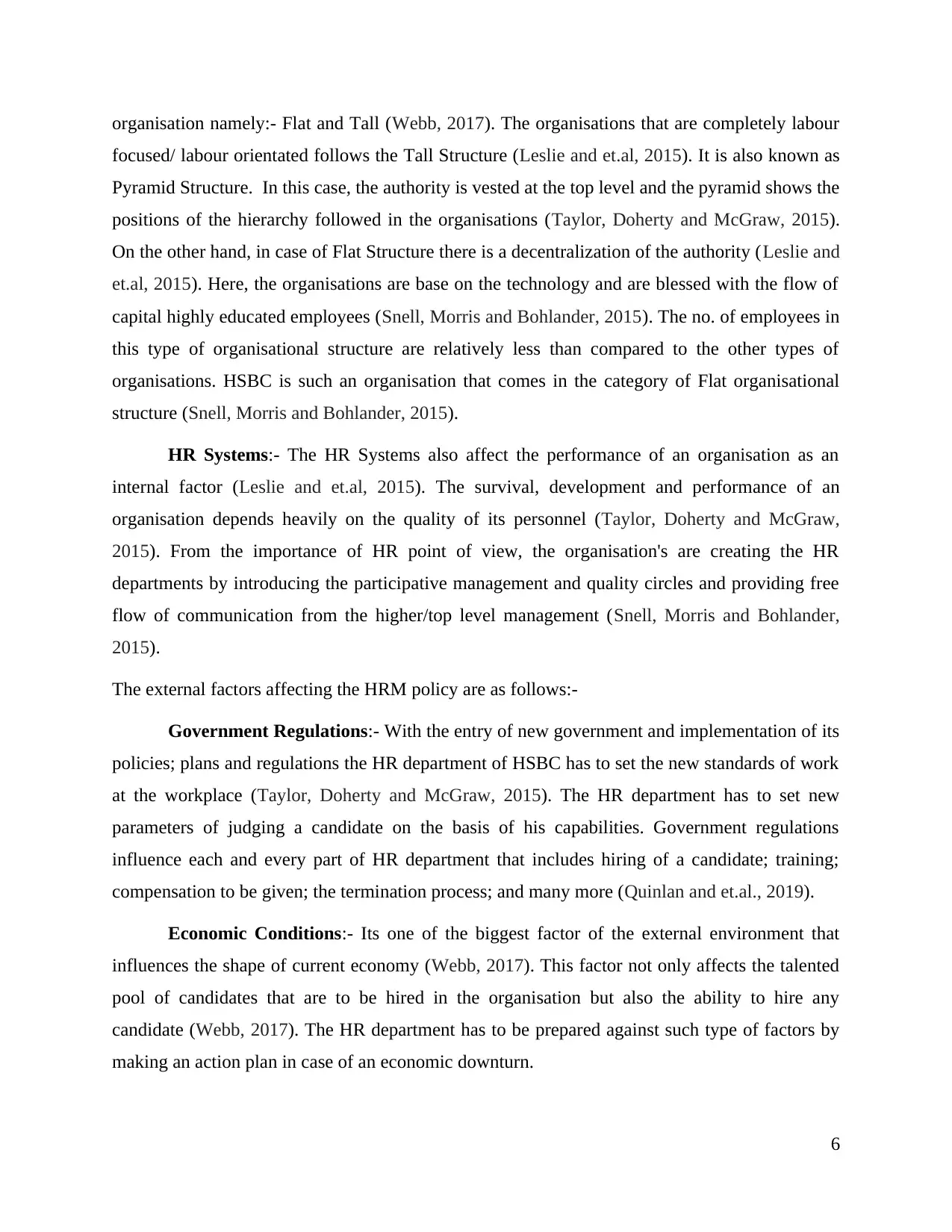
organisation namely:- Flat and Tall (Webb, 2017). The organisations that are completely labour
focused/ labour orientated follows the Tall Structure (Leslie and et.al, 2015). It is also known as
Pyramid Structure. In this case, the authority is vested at the top level and the pyramid shows the
positions of the hierarchy followed in the organisations (Taylor, Doherty and McGraw, 2015).
On the other hand, in case of Flat Structure there is a decentralization of the authority (Leslie and
et.al, 2015). Here, the organisations are base on the technology and are blessed with the flow of
capital highly educated employees (Snell, Morris and Bohlander, 2015). The no. of employees in
this type of organisational structure are relatively less than compared to the other types of
organisations. HSBC is such an organisation that comes in the category of Flat organisational
structure (Snell, Morris and Bohlander, 2015).
HR Systems:- The HR Systems also affect the performance of an organisation as an
internal factor (Leslie and et.al, 2015). The survival, development and performance of an
organisation depends heavily on the quality of its personnel (Taylor, Doherty and McGraw,
2015). From the importance of HR point of view, the organisation's are creating the HR
departments by introducing the participative management and quality circles and providing free
flow of communication from the higher/top level management (Snell, Morris and Bohlander,
2015).
The external factors affecting the HRM policy are as follows:-
Government Regulations:- With the entry of new government and implementation of its
policies; plans and regulations the HR department of HSBC has to set the new standards of work
at the workplace (Taylor, Doherty and McGraw, 2015). The HR department has to set new
parameters of judging a candidate on the basis of his capabilities. Government regulations
influence each and every part of HR department that includes hiring of a candidate; training;
compensation to be given; the termination process; and many more (Quinlan and et.al., 2019).
Economic Conditions:- Its one of the biggest factor of the external environment that
influences the shape of current economy (Webb, 2017). This factor not only affects the talented
pool of candidates that are to be hired in the organisation but also the ability to hire any
candidate (Webb, 2017). The HR department has to be prepared against such type of factors by
making an action plan in case of an economic downturn.
6
focused/ labour orientated follows the Tall Structure (Leslie and et.al, 2015). It is also known as
Pyramid Structure. In this case, the authority is vested at the top level and the pyramid shows the
positions of the hierarchy followed in the organisations (Taylor, Doherty and McGraw, 2015).
On the other hand, in case of Flat Structure there is a decentralization of the authority (Leslie and
et.al, 2015). Here, the organisations are base on the technology and are blessed with the flow of
capital highly educated employees (Snell, Morris and Bohlander, 2015). The no. of employees in
this type of organisational structure are relatively less than compared to the other types of
organisations. HSBC is such an organisation that comes in the category of Flat organisational
structure (Snell, Morris and Bohlander, 2015).
HR Systems:- The HR Systems also affect the performance of an organisation as an
internal factor (Leslie and et.al, 2015). The survival, development and performance of an
organisation depends heavily on the quality of its personnel (Taylor, Doherty and McGraw,
2015). From the importance of HR point of view, the organisation's are creating the HR
departments by introducing the participative management and quality circles and providing free
flow of communication from the higher/top level management (Snell, Morris and Bohlander,
2015).
The external factors affecting the HRM policy are as follows:-
Government Regulations:- With the entry of new government and implementation of its
policies; plans and regulations the HR department of HSBC has to set the new standards of work
at the workplace (Taylor, Doherty and McGraw, 2015). The HR department has to set new
parameters of judging a candidate on the basis of his capabilities. Government regulations
influence each and every part of HR department that includes hiring of a candidate; training;
compensation to be given; the termination process; and many more (Quinlan and et.al., 2019).
Economic Conditions:- Its one of the biggest factor of the external environment that
influences the shape of current economy (Webb, 2017). This factor not only affects the talented
pool of candidates that are to be hired in the organisation but also the ability to hire any
candidate (Webb, 2017). The HR department has to be prepared against such type of factors by
making an action plan in case of an economic downturn.
6

Workforce Demographics:- It's the duty of HR department to hire and recruit an
enthusiast; talented and a fresh candidate in the organisation who is having the capability to
change the current situation of an organisation as per his wits (Quinlan and et.al., 2019). The
organisation should retrench the old workforce in the organisation. Reason being, their ideas and
their ways of working in the organisation are outdated (Snell, Morris and Bohlander, 2015).
HSBC is giving chance to the new candidates who can set a newer way of working in the
organisation. Although, the hiring of new candidates increases the expenses of organisation, but,
it could be controlled by the HR department, by giving training to the existing employees and
offering them increased salary (Snell, Morris and Bohlander, 2015).
Technological Advancement:- This one is considered to be the external factor that
affects the working of Human Resource Department (Webb, 2017). The reason behind this is
very simple, that, when the new technologies are introduced in the market then, then, it is the
duty of the HR department to look in to the matter and should go for the ways through which
money can be saved (Leslie and et.al, 2015). With the advancement of technology, the job of 2-4
persons can be made done by a single person. So, on one hand it brings, unemployment of people
and is working as a factor that affects external environment. HSBC should retrain or release the
currentv employees of the organisation, if their skills are no longer relevant to the use of
organisation.
Social And Cultural Environment:- It is such an environment, that affects the business
and have a negative influence on the Human Resource Management of that organisation (Van
Der Vegt and et.al., 2015). Such type of environment includes:- Ethical and morale values of an
employee; Attitude towards work and Employee motivation (Riley, 2014). The human resource
department must asses such type of factors accordingly. Social and Ethical views of role of
employees in the business also lays a significant influence on the operational pattern of HRM
(Riley, M., 2014).
Legal Environment:- The organisation should provide its employees such an
environment which is completely free from drugs; discrimination of any type; disparate impact;
and anything such problems that are creating issues at the workplace. The organisation should
leave its employees at fix time that is after completion of 09:00 hours of work that is assigned to
the employee. Before, hiring any employee at the workplace the organisation should check
7
enthusiast; talented and a fresh candidate in the organisation who is having the capability to
change the current situation of an organisation as per his wits (Quinlan and et.al., 2019). The
organisation should retrench the old workforce in the organisation. Reason being, their ideas and
their ways of working in the organisation are outdated (Snell, Morris and Bohlander, 2015).
HSBC is giving chance to the new candidates who can set a newer way of working in the
organisation. Although, the hiring of new candidates increases the expenses of organisation, but,
it could be controlled by the HR department, by giving training to the existing employees and
offering them increased salary (Snell, Morris and Bohlander, 2015).
Technological Advancement:- This one is considered to be the external factor that
affects the working of Human Resource Department (Webb, 2017). The reason behind this is
very simple, that, when the new technologies are introduced in the market then, then, it is the
duty of the HR department to look in to the matter and should go for the ways through which
money can be saved (Leslie and et.al, 2015). With the advancement of technology, the job of 2-4
persons can be made done by a single person. So, on one hand it brings, unemployment of people
and is working as a factor that affects external environment. HSBC should retrain or release the
currentv employees of the organisation, if their skills are no longer relevant to the use of
organisation.
Social And Cultural Environment:- It is such an environment, that affects the business
and have a negative influence on the Human Resource Management of that organisation (Van
Der Vegt and et.al., 2015). Such type of environment includes:- Ethical and morale values of an
employee; Attitude towards work and Employee motivation (Riley, 2014). The human resource
department must asses such type of factors accordingly. Social and Ethical views of role of
employees in the business also lays a significant influence on the operational pattern of HRM
(Riley, M., 2014).
Legal Environment:- The organisation should provide its employees such an
environment which is completely free from drugs; discrimination of any type; disparate impact;
and anything such problems that are creating issues at the workplace. The organisation should
leave its employees at fix time that is after completion of 09:00 hours of work that is assigned to
the employee. Before, hiring any employee at the workplace the organisation should check
7
⊘ This is a preview!⊘
Do you want full access?
Subscribe today to unlock all pages.

Trusted by 1+ million students worldwide

whether the employee is having any criminal record or not (Riley, 2014). If the employee is
having any type of criminal background, job should not be offered to such employee.
CONCLUSION:-
The above report is focusing on the ways that a Human Resource Manager should adapt
to take this organisation to a better place. The report is laying its focus on the internal and
external environmental factors that affects the working of the firm in the business environment.
The policies and practices of a firm that is affected by these factors. The report further focuses on
the justification of effective policies and process that help an organisation in the achievement of
a desired goal and its contribution to a competitive advantage. In this report the example of
HSBC has been taken which has achieved a competitive advantage in last 15 years.
8
having any type of criminal background, job should not be offered to such employee.
CONCLUSION:-
The above report is focusing on the ways that a Human Resource Manager should adapt
to take this organisation to a better place. The report is laying its focus on the internal and
external environmental factors that affects the working of the firm in the business environment.
The policies and practices of a firm that is affected by these factors. The report further focuses on
the justification of effective policies and process that help an organisation in the achievement of
a desired goal and its contribution to a competitive advantage. In this report the example of
HSBC has been taken which has achieved a competitive advantage in last 15 years.
8
Paraphrase This Document
Need a fresh take? Get an instant paraphrase of this document with our AI Paraphraser

REFERENCES
Books And Journals
Armstrong, M. and Taylor, S., 2014. Armstrong's handbook of human resource management
practice. Kogan Page Publishers.
Bamberger, P. A., Meshoulam, I. and Biron, M., 2014. Human resource strategy: Formulation,
implementation, and impact. Routledge.
Burt, R. S., 2017. Structural holes versus network closure as social capital. In Social capital (pp.
31-56). Routledge.
Cardy, R. and Leonard, B., 2014. Performance Management: Concepts, Skills and Exercises:
Concepts, Skills and Exercises. Routledge.
Chelladurai, P. and Kerwin, S., 2017. Human resource management in sport and recreation.
Human Kinetics.
Helmreich, R. L. and Merritt, A. C., 2017, November. 11 Safety and error management: The role
of crew resource management. In Aviation Resource Management: Proceedings of the
Fourth Australian Aviation Psychology Symposium: v. 1: Proceedings of the Fourth
Australian Aviation Psychology Symposium. Routledge.
Peltier, T. R., 2016. Information Security Policies, Procedures, and Standards: guidelines for
effective information security management. Auerbach Publications.
Quinlan, C., Babin, B., Carr, J. and Griffin, M., 2019. Business research methods. South Western
Cengage.
Riley, M., 2014. Human resource management in the hospitality and tourism industry.
Routledge.
Snell, S., Morris, S. and Bohlander, G.W., 2015. Managing human resources. Nelson Education.
Taylor, T., Doherty, A. and McGraw, P., 2015. Managing people in sport organizations: A
strategic human resource management perspective. Routledge.
Turner, R., 2016. Gower handbook of project management. Routledge.
Van Der Vegt, G. S., and et.al., 2015. Managing risk and resilience.
9
Books And Journals
Armstrong, M. and Taylor, S., 2014. Armstrong's handbook of human resource management
practice. Kogan Page Publishers.
Bamberger, P. A., Meshoulam, I. and Biron, M., 2014. Human resource strategy: Formulation,
implementation, and impact. Routledge.
Burt, R. S., 2017. Structural holes versus network closure as social capital. In Social capital (pp.
31-56). Routledge.
Cardy, R. and Leonard, B., 2014. Performance Management: Concepts, Skills and Exercises:
Concepts, Skills and Exercises. Routledge.
Chelladurai, P. and Kerwin, S., 2017. Human resource management in sport and recreation.
Human Kinetics.
Helmreich, R. L. and Merritt, A. C., 2017, November. 11 Safety and error management: The role
of crew resource management. In Aviation Resource Management: Proceedings of the
Fourth Australian Aviation Psychology Symposium: v. 1: Proceedings of the Fourth
Australian Aviation Psychology Symposium. Routledge.
Peltier, T. R., 2016. Information Security Policies, Procedures, and Standards: guidelines for
effective information security management. Auerbach Publications.
Quinlan, C., Babin, B., Carr, J. and Griffin, M., 2019. Business research methods. South Western
Cengage.
Riley, M., 2014. Human resource management in the hospitality and tourism industry.
Routledge.
Snell, S., Morris, S. and Bohlander, G.W., 2015. Managing human resources. Nelson Education.
Taylor, T., Doherty, A. and McGraw, P., 2015. Managing people in sport organizations: A
strategic human resource management perspective. Routledge.
Turner, R., 2016. Gower handbook of project management. Routledge.
Van Der Vegt, G. S., and et.al., 2015. Managing risk and resilience.
9

Webb, S. P., 2017. Knowledge management: Linchpin of change. Routledge.
Wellin, M., 2016. Managing the psychological contract: Using the personal deal to increase
business performance. Routledge.
ONLINE:
Internal And External Factors Affecting HRM. 2018. [Online]. Available through
<https://bizfluent.com/info-8612477-internal-factors-affecting-human-resources.html>
10
Wellin, M., 2016. Managing the psychological contract: Using the personal deal to increase
business performance. Routledge.
ONLINE:
Internal And External Factors Affecting HRM. 2018. [Online]. Available through
<https://bizfluent.com/info-8612477-internal-factors-affecting-human-resources.html>
10
⊘ This is a preview!⊘
Do you want full access?
Subscribe today to unlock all pages.

Trusted by 1+ million students worldwide
1 out of 12
Related Documents
Your All-in-One AI-Powered Toolkit for Academic Success.
+13062052269
info@desklib.com
Available 24*7 on WhatsApp / Email
![[object Object]](/_next/static/media/star-bottom.7253800d.svg)
Unlock your academic potential
Copyright © 2020–2025 A2Z Services. All Rights Reserved. Developed and managed by ZUCOL.




